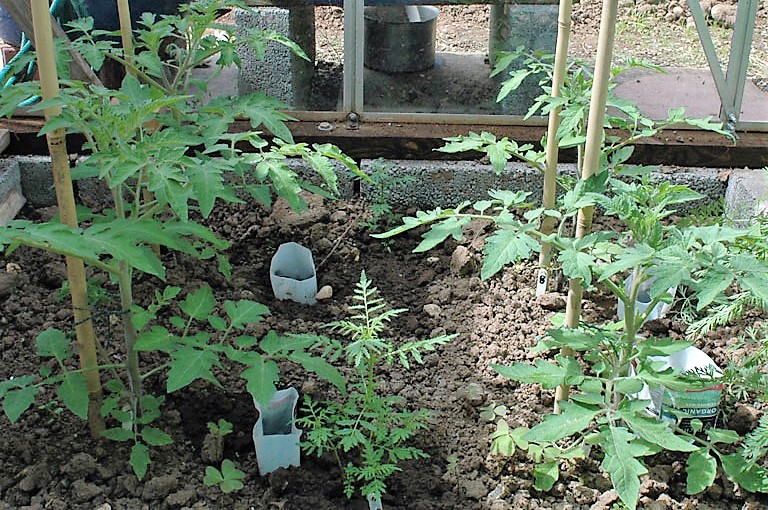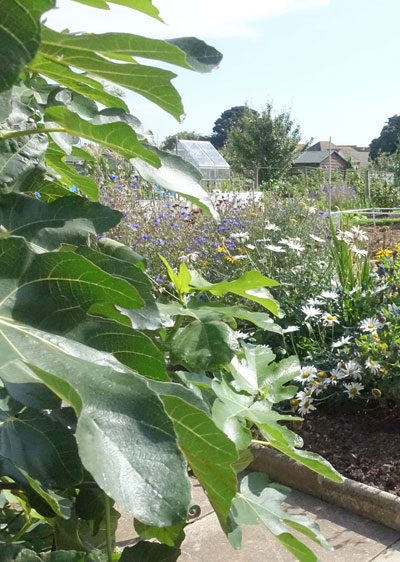Watering -To develop healthy, drought resistant plants roots need to be encouraged to go deep to find water and nutrients so careful watering is essential. Always spot water at the base of the plant to get water to the roots. Spraying water only dampens the surface soil and this means that plants will only develop shallow roots.
The best time of day to water is early morning so that evaporation is reduced and the plants get all of the water. The second best time to water is the evening taking great care not to soak leaves. Plants that have wet leaves at night will be prone to fungus and diseases.
 Tomatoes, courgettes and squashes will become big, water hungry plants so an upturned, bottomless bottle buried alongside the seedling at planting time will enable you to give it the water it needs as it grows.
Tomatoes, courgettes and squashes will become big, water hungry plants so an upturned, bottomless bottle buried alongside the seedling at planting time will enable you to give it the water it needs as it grows.
A good soak once a week is better for your plants than frequent sprinkles.
Seedlings do need regular watering to establish. Put plenty of water in your planting hole. Leave a small hollow in the soil around your plant so that when you water it runs in towards the plant not away from it. Water just enough each day to keep the soil damp for at least a week after planting.
Sowing -The soil is now warm enough for direct sowings - ideal for brassicas which don’t like being moved. Check packets for correct varieties for this month.
The pea family can be direct sown this month.
Florence fennel - Why not try some Florence fennel. Now is a good time to direct sow so that plants mature later in the season and don’t bolt.
Continue with successional sowings of carrots, beetroot, turnips and salad crops.
Blight - The warmth in June is ideal for plant growth but if the weather is also wet it will provide conditions in which fungal diseases thrive. This could trigger tomato or potato blight so, look out for brown patches on potato leaf tips followed by dark patches on the stems which will then collapse. If blight occurs everyone will have it so check with your neighbours before you start panicking. Remove the damaged foliage to stop the fungus going into the potatoes – they won’t grow any more but they can stay in the soil. Destroy the dead plant - do not compost it.
When warm wet weather is forecast tomatoes can be sprayed with a copper fungicide such as to prevent blight. Remove and destroy any infected foliage.
Potatoes - Early potatoes take about 100 days to grow, second earlies 120 days and maincrop 140 days. So it will be worth carefully investigating your earlies this month to see if they are ready.
 Strawberries - Runners on strawberries weaken the plant so remove most of them just leaving one per plant for propagation. Strawberries only fruit well for three years. After that you need new plants in fresh ground. Another way to do it is to renew a third of your crop each year. Straw around strawberries will help ripening and reduce slug and woodlouse damage.
Strawberries - Runners on strawberries weaken the plant so remove most of them just leaving one per plant for propagation. Strawberries only fruit well for three years. After that you need new plants in fresh ground. Another way to do it is to renew a third of your crop each year. Straw around strawberries will help ripening and reduce slug and woodlouse damage.
Leeks – Now is the right time to plant your leek seedlings. There are several ways to do this so look around to see what your neighbours are doing.
Crop protection - Make sure your brassicas are netted to protect them from cabbage white butterflies and pigeons.
Keep plot clear of old withered foliage because this attracts slugs. Slugs don't like hot dry weather, so an evening patrol is a good time to collect them. You can put down small pots of beer as traps to catch slugs and if you must use pellets please use them with great care.
Upkeep – It’s peak growing time now -this includes weeds, so you will need to hoe regularly. Also strim and mow paths so that you are not sharing dandelion seeds with your neighbours.
